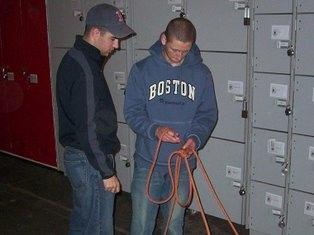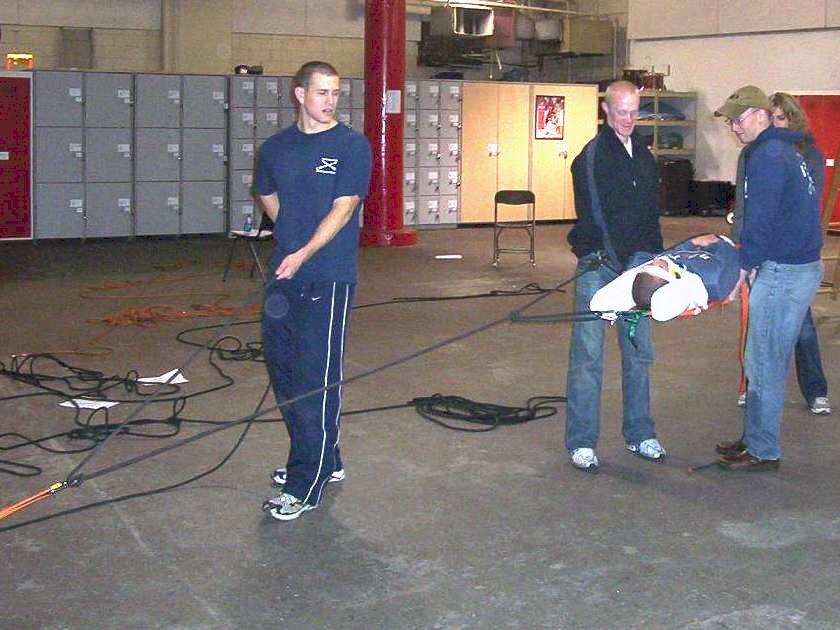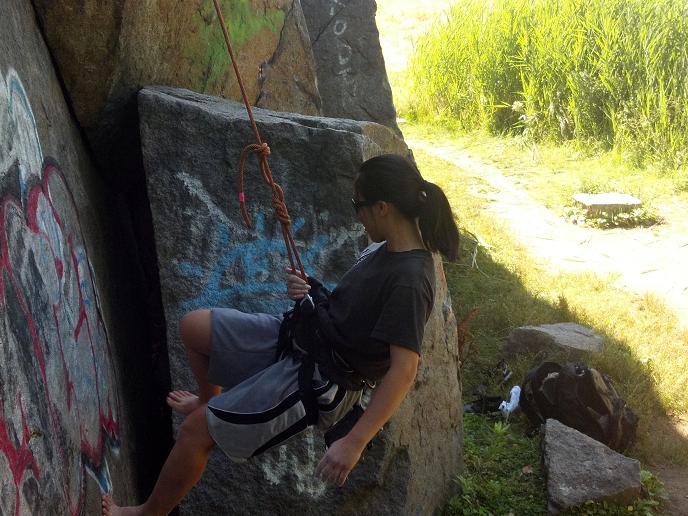

 Future military officers know that they may someday need to use ropes and rigging systems in order to safely and efficiently move personnel, equipment, or casualties on the battlefield. As such, B-12 has added a rope work class to its already intense training curriculum. The class is designed to reinforce the rappelling training which most ROTC cadets receive during field exercises, and to additionally teach how to actually set up several types of rope systems by using various rigging methods.
Future military officers know that they may someday need to use ropes and rigging systems in order to safely and efficiently move personnel, equipment, or casualties on the battlefield. As such, B-12 has added a rope work class to its already intense training curriculum. The class is designed to reinforce the rappelling training which most ROTC cadets receive during field exercises, and to additionally teach how to actually set up several types of rope systems by using various rigging methods.
 The class begins with the basics of all rope work: knots. B-12 members are taught how to tie several different types of knots, and learn which knots are appropriate for which systems. The Figure-8, Figure-8 Followthrough, Figure-8 Loop, Fisherman’s Knot, Water Knot, Munter Hitch, Alpine Butterfly, and Prusik Knot/Hitch are examples of some of the most commonly used knots in rope work. B-12 members become adept at tying these knots and ensuring that they are tied correctly and used appropriately. Then it’s on to rigging.
The class begins with the basics of all rope work: knots. B-12 members are taught how to tie several different types of knots, and learn which knots are appropriate for which systems. The Figure-8, Figure-8 Followthrough, Figure-8 Loop, Fisherman’s Knot, Water Knot, Munter Hitch, Alpine Butterfly, and Prusik Knot/Hitch are examples of some of the most commonly used knots in rope work. B-12 members become adept at tying these knots and ensuring that they are tied correctly and used appropriately. Then it’s on to rigging.
 Perhaps the most commonly used rope system is the rappel station, in which a person uses the rope to slow their descent down a cliff or steep slope. Members are taught how to choose suitable anchors (such as a strong tree), and how to rig the rappelling rope to the anchor and secure it in place. They then learn how to properly don a climbing/rappelling harness, and how to set up the harness and descender device for use in a rappel. Due to the potential for catastrophe if any element of the system fails, special emphasis is placed on avoiding the pitfalls of improperly securing the harness or descender, before actually starting the rappel. Members also learn to double-check each other’s work, in order to ensure the safety of all personnel.
Perhaps the most commonly used rope system is the rappel station, in which a person uses the rope to slow their descent down a cliff or steep slope. Members are taught how to choose suitable anchors (such as a strong tree), and how to rig the rappelling rope to the anchor and secure it in place. They then learn how to properly don a climbing/rappelling harness, and how to set up the harness and descender device for use in a rappel. Due to the potential for catastrophe if any element of the system fails, special emphasis is placed on avoiding the pitfalls of improperly securing the harness or descender, before actually starting the rappel. Members also learn to double-check each other’s work, in order to ensure the safety of all personnel.
 After learning to rig a rappel station, B-12 members move on to setting up a top rope climbing station, in which one person climbs up while another person belays the climber. Again, emphasis is placed on safety. Members learn which type of rope should be used for climbing, how to properly tie in a climber to the rope, and how to safely belay that climber during the climb. They also learn how to set up the rigging at the top of the climb, so as to protect the rope from damage and ensure the safety of the climber. Due to limitations in equipment and climbing locations, lead climbing is discussed, but not practiced.
After learning to rig a rappel station, B-12 members move on to setting up a top rope climbing station, in which one person climbs up while another person belays the climber. Again, emphasis is placed on safety. Members learn which type of rope should be used for climbing, how to properly tie in a climber to the rope, and how to safely belay that climber during the climb. They also learn how to set up the rigging at the top of the climb, so as to protect the rope from damage and ensure the safety of the climber. Due to limitations in equipment and climbing locations, lead climbing is discussed, but not practiced.
 In addition to setting up rappelling and climbing stations, B-12 members learn various rescue and self-rescue techniques, such as how to ascend and descend the rope using prusik hitches, and how to transition from a prusik hitch ascension to a rappel. Members also learn how to set up a secure lowering system and how to rig a backboard or litter for lowering, after having packaged the patient using techniques learned during B-12 medical training. They then learn how to belay the rescuers and the litter together down to safety.
In addition to setting up rappelling and climbing stations, B-12 members learn various rescue and self-rescue techniques, such as how to ascend and descend the rope using prusik hitches, and how to transition from a prusik hitch ascension to a rappel. Members also learn how to set up a secure lowering system and how to rig a backboard or litter for lowering, after having packaged the patient using techniques learned during B-12 medical training. They then learn how to belay the rescuers and the litter together down to safety.
 Members usually come away from the ropework class with a more thorough understanding of the principles involved in rope work, and a deeper familiarity with the specific knots and rigging systems. This knowledge is then reinforced during ROTC events and other B-12 training. As with all B-12 training, members are subsequently expected to be able to use the skills they have learned, and teach them to future Pershing Rifles candidates and members both during and after Candidate Term.
Members usually come away from the ropework class with a more thorough understanding of the principles involved in rope work, and a deeper familiarity with the specific knots and rigging systems. This knowledge is then reinforced during ROTC events and other B-12 training. As with all B-12 training, members are subsequently expected to be able to use the skills they have learned, and teach them to future Pershing Rifles candidates and members both during and after Candidate Term.